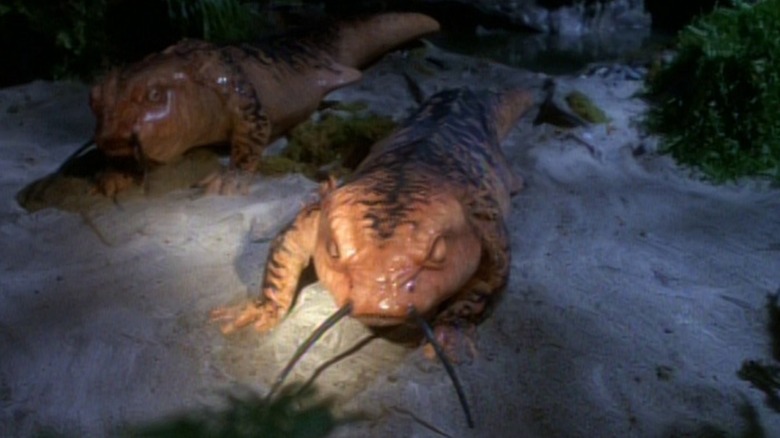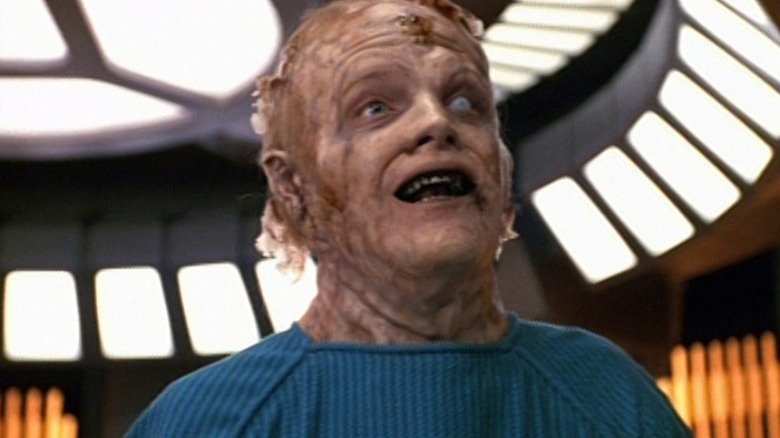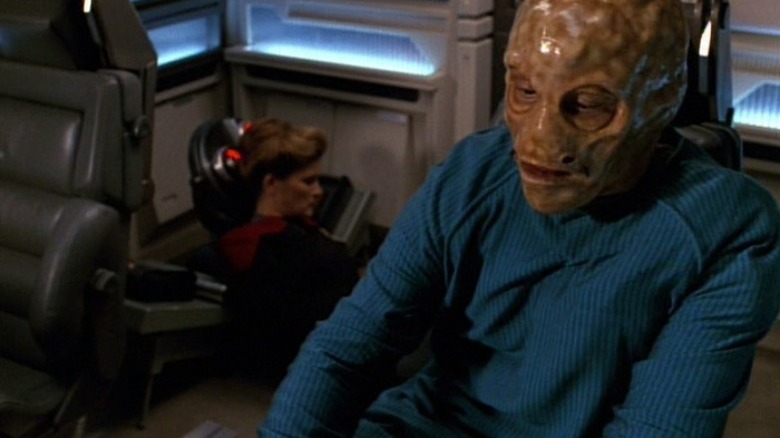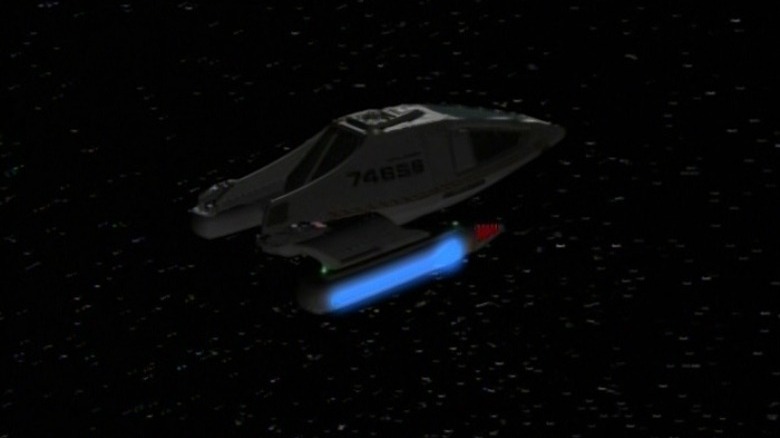Why Star Trek: Voyager's Threshold Episode Ignited An Army Of Outraged Fans
In the "Star Trek: Voyager" episode "Threshold" (January 9, 1996), the U.S.S. Voyager discovers a rare, extra-powerful version of dilithium, the crystal that is required to run starship engines. Using this new dilithium, the Voyager crew figure they can build an engine capable of passing the mythic warp-10 barrier, essentially allowing them to reach infinite velocity, passing through every point in the universe simultaneously. Such a breakthrough would allow the Voyager to return to Earth in a moment.
When testing their new engine, however, something goes awry. Tom Paris (Robert Duncan McNeill) returns from a test flight ... altered. He begins to mutate and change, losing skin and spitting out his tongue. It seems that the infinite velocity flight somehow triggered his body's evolutionary genes and he is rapidly transforming into whatever creatures humans will evolve into in the next hundred million years. When Paris becomes an amphibian-like frog man, he kidnaps Captain Janeway (Kate Mulgrew) and forces her to take the infinite warp flight while unconscious.
The episode ends with the Voyager crew locating Paris and Janeway, and discovering that they had evolved into fleshy, outsize newts. Also, they mated, spawning several efts. This was the apex of evolution. Big, weird newts. The Voyager's doctor (Robert Picardo) transforms them back into humans.
It seems the newts weren't well-received by fans. In the 1996 book "Captains' Logs Supplemental: The Unauthorized Guide to the New Trek Voyages" by Mark A. Altman and Edward Gross, "Voyager" producer Jeri Taylor talked about the negative fan mail the show received for "Threshold," and how awful those newts were. Fans were also angry at some of the technical details, feeling that "Voyager" crossed a line.
The Warp 10 Barrier
Taylor, firstly, remembered the backlash over the warp-10 barrier, and it's easy to see why. While the ships on "Star Trek" can travel at tremendous speeds, even their fictional warp engines have to contend with the real-life enormity of space. Even the U.S.S. Voyager, one of the fastest ships ever built, requires 70 straight years of traveling at its top speed just to cross the Milky Way. The idea of a ship breaking that barrier and reaching infinite velocity would remove all the trekking from "Star Trek." It would be as if a starship could teleport, and what dummy would think to write a "Star Trek" series about a ship that can teleport?
Taylor recalled hearing from angry Trekkies on the matter, saying:
"We're taking a lot of flak for that [...] There's been a real lashing out. I recognize that people who are on the Internet and who write us letters are a tiny portion of our audience, but when it is as overwhelming as it was on this episode, you begin to take notice. Some of this anger was misplaced, I thought. A lot of the ire seemed to be caused by the fact that we stated that no one had ever gone warp ten before, and people flooded us with letters saying. That's not true, in the original series they went warp twelve and warp thirteen."
Taylor, of course, knew all about the history of Trek, and calmly pointed out the recalibration done with the franchise's lore. Ultimately, she was more concerned with the story than with explaining the history of Trek tech. Indeed, Trekkies would know about the recalibration anyway. Fans were just being snotty, it seems.
Staying away from big heads
She continued:
"[I]t really was a recalibration of warp speed. Gene [Roddenberry] made the determination at the beginning of 'Next Gen' that warp ten would be the limit, and at that point you would occupy all portions of the universe simultaneously, which always seemed like a wonderfully provocative notion. Then the question is 'What happens if you do go to warp ten, how does that affect you?'"
That focus on the story led to some fun postulations about evolution. In many sci-fi stories, when humans find themselves suddenly evolving — at least to Taylor's recollection — they suddenly have larger heads and spindly bodies. Taylor and the show's writers wanted something different and unexpected. Hence the newts. Taylor said:
"[We] came up with this idea of evolution and thought that it would be far more interesting and less expected that instead of it being the large-brained, glowing person, it would be full circle, back to our origins in the water. Not saying that we have become less than we are, because those creatures may experience consciousness on such an advanced plane that we couldn't conceive of it. It just seemed like a more interesting image. But it is not one that took with the audience."
A fine idea, but in execution, it seems that Trekkies were put off. At the end of the day, one is pointing a camera a giant newt puppets. Trekkies weren't happy with that. "The fact that we were turning people into salamanders," Taylor said, "was offensive to a lot of people and just plain stupid to others."
Braga's opacity
"Threshold" was credited to longtime "Star Trek" veteran Brannon Braga, notorious for writing the headier, more psychedelic episodes. Braga recalled the scientific notions behind the newts, but that he didn't bother to explain them with clarity. In an episode that was already hefty with technobabble and scientific dialogue about velocity and evolution, Braga felt he needed to pare things down a little bit. Sadly, in so doing, he chopped out something that would have made ultra-evolved space-newts more acceptable. He said:
"['Threshold' is] very much a classic 'Star Trek' story. But in the rewrite process, I took out the explanation, the idea behind the ending; that we evolve into these little lizards because maybe evolution is not always progressive. Maybe it's a cycle where we revert to something more rudimentary. That whole conversation was taken out for various reasons, and that was a disaster because without it the episode doesn't even have a point. I think it suffered greatly. I got the note that it wasn't necessary, but in fact, it really had a lot to do with what the episode was about. Big mistake taking it out."
Indeed, evolution is a long-term transformation wherein organisms adapt to a changing environment. It is not necessarily a gradual movement toward a type of pre-determined complexity. "Threshold" possesses that idea, but it's not part of the dialogue. Not having a character speak it aloud leaves the episode's themes murky. Instead, audiences simply have to accept the absurd notion that two main cast members turned into amphibians.
Fun trivia: "Threshold" was initially pitched by longtime Trekkie Michael De Luca, who, at the time, was best known for writing the screenplays for "Freddy's Dead: The Final Nightmare" and John Carpenter's "In the Mouth of Madness."



